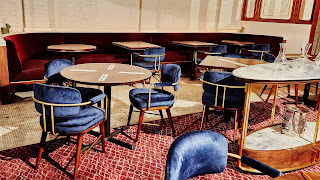When you walk into a cafe, what draws you in and makes you want to stay? Beyond the aroma of freshly brewed coffee and the promise of a delicious treat, the ambiance plays a crucial role. At the heart of this ambiance is the seating. Comfortable seating in cafe interior design is not just about aesthetics; it’s a vital element that can significantly impact the customer experience and the overall success of the establishment.
1. First Impressions Matter
From the moment a customer steps into a cafe, they start forming opinions. The seating arrangement and comfort level are among the first things they notice. Plush chairs, cozy sofas, and well-cushioned seats invite customers to sit down and relax, setting a positive tone for their visit. On the other hand, hard, uncomfortable seating can deter customers from staying longer, affecting their overall experience.
2. Encouraging Longer Stays
One of the main goals for any cafe is to encourage customers to stay longer. Comfortable seating plays a pivotal role in achieving this. When customers feel at ease, they are more likely to linger, order more items, and even return for future visits. This is particularly important for cafes aiming to create a community feel or become a preferred spot for meetings, study sessions, or casual hangouts.
3. Enhancing Customer Experience
Comfortable seating directly enhances the customer experience. Imagine trying to enjoy a hot cup of coffee while constantly shifting in your seat to find a comfortable position. It’s distracting and unpleasant. Good seating allows customers to focus on their coffee, conversation, or work without discomfort. This positive experience makes customers more likely to recommend the cafe to others and leave positive reviews.
4. Reflecting the Cafe’s Brand and Style
Seating is a crucial aspect of cafe interior design that reflects the brand’s identity and style. A cafe with luxurious armchairs and soft lighting creates a different vibe compared to one with sleek, minimalist seating. The choice of furniture can convey messages about the cafe’s values, whether it’s a focus on luxury, sustainability, or modernity. This alignment between seating and brand identity helps in attracting the target audience.
5. Maximizing Space Utilization
Comfortable seating doesn’t necessarily mean large, bulky furniture. In fact, smart cafe interior design can combine comfort with space efficiency. Thoughtful arrangements and the use of multi-functional furniture can maximize seating capacity without compromising on comfort. For instance, built-in benches with cushions can save space while providing a cozy seating option.
6. Catering to Different Needs
A successful cafe interior design considers the diverse needs of its customers. Some patrons may come alone for a quiet reading session, while others might visit in groups. Providing a mix of seating options, such as single chairs, communal tables, and lounge areas, ensures that all customer preferences are catered to. Comfortable seating for all these different needs ensures a welcoming environment for everyone.
7. Health and Ergonomics
Ergonomics should not be overlooked in cafe seating. Poorly designed chairs can lead to discomfort and health issues such as back pain. Ergonomic seating supports good posture and overall well-being, making the cafe a pleasant place to spend time. Investing in ergonomic furniture can demonstrate a cafe’s commitment to the health and comfort of its customers.
8. Creating an Inviting Atmosphere
The arrangement and style of seating contribute significantly to the overall atmosphere of the cafe. Cozy corners with soft chairs create intimate spaces, while large tables with comfortable chairs foster a communal and social environment. The key is to create an inviting atmosphere where customers feel at home and are encouraged to return.
9. Impact on Customer Behavior
Comfortable seating can subtly influence customer behavior. Customers who feel comfortable are more likely to order additional items, such as a second cup of coffee or a dessert. They may also stay longer, increasing the likelihood of higher spending. Comfortable seating thus has a direct impact on the cafe’s revenue.
10. Practical Considerations
While comfort is paramount, practical considerations also come into play in cafe interior design. Seating should be durable and easy to clean, especially in high-traffic areas. High-quality materials that withstand daily wear and tear ensure that the seating remains comfortable and attractive over time. Additionally, furniture that is easy to move and rearrange offers flexibility for different events and peak times.
Conclusion
In conclusion, comfortable seating is a cornerstone of effective cafe interior design. It influences first impressions, encourages longer stays, enhances the customer experience, and reflects the cafe’s brand. By catering to diverse needs, considering ergonomics, and creating an inviting atmosphere, cafes can ensure that their seating contributes positively to their success. Practical considerations such as durability and flexibility further enhance the value of good seating. Ultimately, comfortable seating is not just about providing a place to sit; it’s about creating an environment where customers feel welcome, relaxed, and eager to return.

